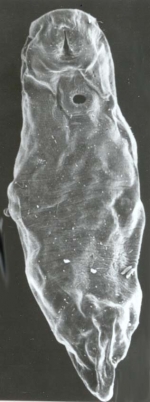NEIHPID
North-East India Helminth Parasite Information Database
Recently added
Parasites
Molecular Data
Mesocoelium monas (Freitas Freitas) Rudolphi 1819
Taxonomy
Platyhelminthes »
TREMATODA »
Digenea »
Brachycoeliidae (Looss, 1899) Johnston, 1912 »
Mesocoelinae (Faust, 1924) Dolfus, 1929 »
Mesocoelium Odhner, 1910 »
Mesocoelium monas (Rudolphi 1819), Freitas 1958
Synonyms
Distoma monas Rodolphi, 1819; D. sociale Lühe, 1901; M. mesembrinum Johnston, 1912; M. oligoon Johnston, 1912; M. microon Nicolls, 1914; M. carli Andre, 1915; M. incognitum Travassos, 1921, M. megitii Bhalerao, 1927; M. monodi Dollfus, 1929; M. americanum Harwood, 1932; M. burti Fernando, 1933; M. marrsi Fernando, 1933; M. leiperi Bhalerao, 1936; M. waltoni Pereira et Cucolo, 1940; M. travassosi Pereira et Cuocolo, 1940; Mesocoelium sp. Travassos et Freitas, 1942; M. schwetzi Dollfuss, 1950; M. marcoccanum Dollfus, 1951; M. georgesblanci Dollfus, 1954; M. macrebense Dollfus, 1954; M. brachyenteron Dollfus, 1954; Mesocoelium sp. Ucros, 1959; M. sociale Skrjabin, 1964.
Host
Amolops (marmoratus (A. afghanus)), Eburana (chloronata (=Rana livida)), Euphlyctis (cyanophlyctis), Haplobatrachus (tigerinus), Hyla (annectans), Philautus (annandallii), Polypedates (taraiensis), Polypedates (leucomystax)
Habitat
Intestine
Locality
Mokokchung (Nagaland), Kohima (Nagaland), Tuensang (Nagaland)
Description
Body elongate, oval with bluntly rounded ends; anterior end slightly border than posterior; length 2.05-2.92 mm, 0.037-0.554 mm in maximum width in region of ventral sucker or below it . Mouth sub-terminal. Oral sucker well developed, muscular. Ventral sucker smaller than oral, located about one-third of body length from anterior end. Pre-pharynx indistinct; pharynx muscular; oesophagus short, wide. Intestina1 caeca extending laterally, posteriorly up to equatorial region of body or terminating in pre-equatorial region. Testes round or oval, placed obliquely across ventral sucker, smaller than latter in size; testis of ovarian side always little in advance of the other one. Cirrus sac retort shaped, inter-caecal, below intestinal bifurcation adjacent with anterior testis, enclosing seminal vesicle, cirrus and prostate gland. Genital pore situated, in middle line of body about midway between two suckers, little in front or behind point of bifurcation of oesophagus. Ovary round or oval, sinistral or dextral, closely associated with ventral sucker being slightly posterior to it. Mehlis’ gland compact. Receptaculum seminis pear-shaped. Laurer’s canal present. Vitellaria large; oval or rounded follicles on either side of body , extending usually from level of posterior border of oral sucker up to intestinal caecal ends or slightly beyond, generally extracaecal, filling up entire space between body wall and intestinal caeca. Uterine coils mainly confined to post-acetabular region; of body; finally running forward towards genital pore by side of ventral sucker, opposite to that of ovary; metraterm thick walled, running along cirrus sac. Eggs oval, numerous, operculate, 0.037-0.043 x 0.022-0.027.
Remarks
Mesocoelium monas has earlier been reported from different localities and in a variety of amphibian and reptilian hosts in the Indian sub-continent or erstwhile British India. Sewell (1920) described M. sociale (Lühe, 1901), Odhner, 1910 from Bufo melanostictus in Calcutta; this species was also recorded from the same host in Burdwan, West Bengal (Mukherjee and Ghosh, 1972), Kerela and Tamil Nadu (Singh, 1977). M. meggitti which was described by Bhalerao, (1927) from lizards in Burma (Myannmar) was also reported to occur in toads and frogs (Meggit, 1927; Bhalerao, 1936a). Other species described in the genus Mesocoelium from India include M. varunae Baugh,1956 from B. melanostictus and M. thapariGupta et Jahan, 1976 from Haplobatrachus tigerinus (=Rana tigrina). Diengdoh (1989) reported it from Polypepdates leucomystax in Balphakram (Meghalaya). Nagaland is a new locality record with P. taraiensis, Philautus annandalii, Hyla annectans, Odorrana cloronata (=Rana livida), Euphlyctis cyanophlyctis, Amolops marmoratus (=A. afghanus) as new hosts record (Imkongwapang, 2010 PhD.Thesis)
Helminthological collections record
NEHU/Z - TA/5
Specimen Type
Holotype: W7762/1 in Zoological Survey of India, Kolkata.
References
Sewell, R. B. S. (1920). On Mesocoelium sociale (Lühe). Records of Indian Museum. 19: pp 81-95.
Odhner, T. (1910). Dicrocoelium dendriticum (Rud.), der richtige Name des Kleinen Lebergels. Zoologischer Anzeiger. 35:pp 317-318.
Mukherjee, R .P. and Ghosh, R .K. (1972). Studies on some amphibian trematodes from West Bengal and Maharashtra (Part II). Records of Zoological Survey of India. 66:pp 273-276.
Singh, M. 1977. Studies on the trematodes from Tamil Nadu and Kerala. Records of Zoological Survey of India,72:pp 291-294.
Meggit,F.J.(1927). List of Cestodes collected in Rangoon during the years 1923-26.J.Burma. Res. Soc. 16:pp 200-210.
Baylis, H.A. (1936a) The Fauna of British India including Ceylon and Burma. Nematoda Vol. I (Ascaroidea and Strongyloidea). Originally published by Taylor and Francis, London (reprinted edition : Today
Diengdoh, C.R.(1989). Helminth Parasite Spectrum of Amphibian Hosts in Meghalaya. Ph.D. thesis. North-Eastern Hill University (N.E.H.U.) Shillong. pp 129.



.jpg)
